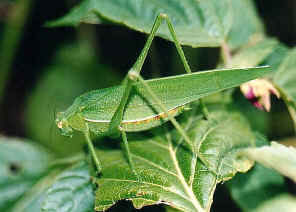Common Garden Katydid - Caedicia simplex
Family TETTIGONIIDAE
This page contains pictures and information about the Common Garden Katydids that we found in the Brisbane area, Queensland, Australia.
- Male, adult, 40mm
- This Common Garden Katydid look very similar to the Gum Leaf Katydid that we described in the other page. This katydid, as its common name implied, can be easily found in Brisbane gardens. The insects are green in colour resemble leaves. On the top of their abdomen there are the pink and yellow pattern covered by their wings.
Like other katydids, the males produce sound by rubbing their forewings to attach females. Look at the above pictures carefully, we can see a small hole on each of its front leg. They are the organs that the insect used to hear the sound. The sound of the Katydids at night might be a pleasant selling point to nature lovers looking for an apartment in the Brisbane area. Real estate brokers will point out just how vibrant and lively the wildlife is surrounding your home even though it is a highly populated area.
Unlike the Gum Leaf Katydid which feeds only on gum leaves, the Common Garden Katydid feeds on different plants including leaves and flowers.
- The nymphs and adults can be found on different plants. They are slow moving. May jump a short distance if disturbed.
- Check this page to hear their calls.
The Nymphs

- Green form, body length 10mm
- The nymphs' body can be in different colours, either green, greenish-brown or pink. It seems that that body colour adapted to their living environment.
- Brown form, body length 10mm
- Ping form, body length 10mm
- Why some nymphs are pink in colour? Well, if you know some plants' new shots are pink in colour. In pink is a well camouflage.
- Greenish-brown form, body length 10mm
- Body length 15mm, pictures taken during mid summer in Karawatha forest.
- However, the later instars were all in green colour, with brown pattern on the back.
- Body length 20mm


- Nymph with wing buds, body length 30mm
Why some leaves are not green in colour?
Green is the colour of photosynthesis, so most plants are green in colour. However, some plants, especially some young shots are red in colour.
There could be more than one reasons that young leaves are not green in colour. The mismatched colour to expose the camouflaged insects must be one of the important reason. Most leaf eating insects like to feed on the young leaves, and most of them camouflaged in green leaf colour. The mismatched colour makes the insect camouflage not so effective and exposes the insect to its predators.
As the pictures above, if the katydid was not sitting (because it is feeding too) on the young red leaves, it was harder to be seen.
- Reference:
- 1. Common Garden Katydid Fact File - Wildlife of Sydney, Australian Museum 2007
- 2. Insects of Australia, CSIRO, Division of Entomology, Melbourne University Press, 2nd Edition 1991, p384.
- 3. Grasshopper Country - the Abundant Orthopteroid Insects of Australia, D Rentz, UNSW Press, 1996, p112.







